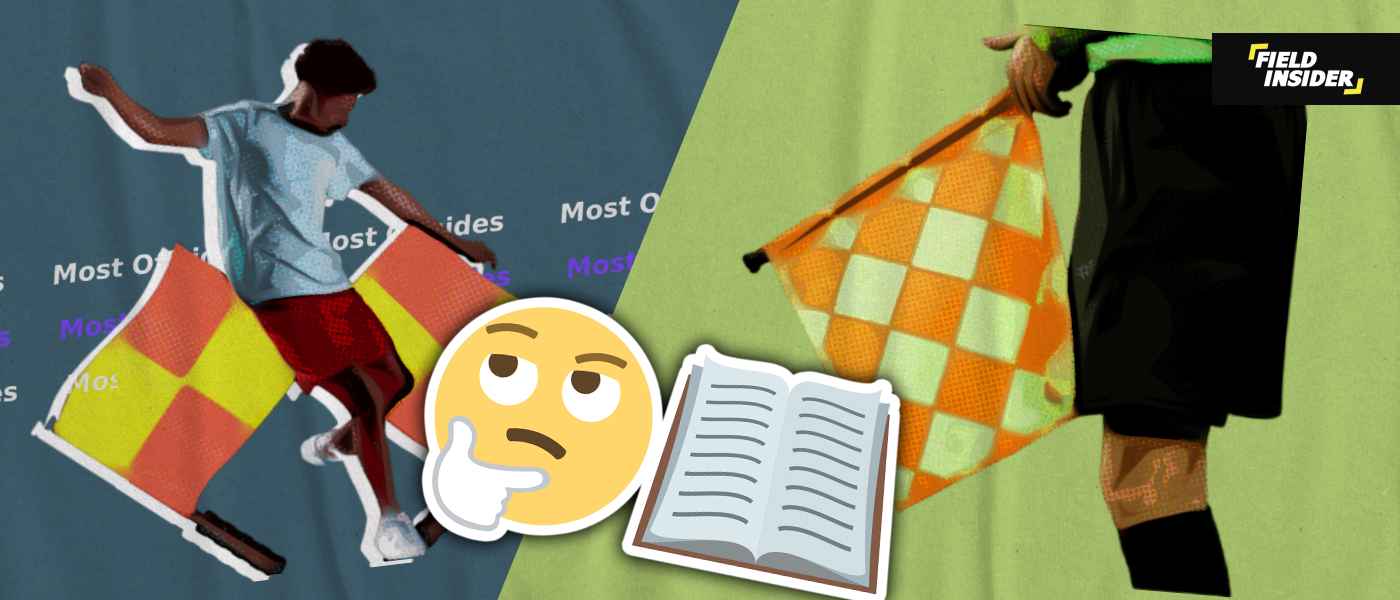The Offside Rule In Football (A Complete Guide)
The offside rule in football, while often perceived as complex, is a cornerstone of the game’s strategy and fairness.
This fundamental rule has undergone changes over the years to ensure the game promotes fairness and, at the same time, doesn’t slow down offensive formations and tactics.
This article aims to unpack this rule in a manner that is both comprehensive and accessible, providing a deeper understanding of one of football’s most fundamental aspects.
Key Takeaway
| Aspects | Details |
|---|---|
| Definition & Significance | Essential for understanding football dynamics. |
| Evolution of the Rule | Historical development and potential future changes. |
| Offside Offenses | Scenarios and conditions for an offside offense. |
| Offside Line Explanation | Significance and determination by defenders. |
| Assistant Referee’s Role | Importance in offside decision-making. |
| Beating the Offside Trap | Tactics used by attackers and defenders. |
| VAR’s Impact | Influence of technology on off-side decisions. |
What is Offside In Football?
Offside in football is often controversial in its meaning and interpretation. However, one thing that I want you to remember as we move down is that offsides are a positioning error.
Before expanding more on offsides as a position, let’s look at the definition of the offside rule.
The offside rule states that an attacking player on the opposing team’s side of the field is offside if his head, legs, or any other part of his body is closer to the opponent’s goal line than the ball and the second last opponent.
In other words, it occurs when an attacking player is closer to the goal line of the opposing team by any part of his body than the ball and the second-last opponent (who is often a defender) while he is on the opposing team side of the field, then he is offside.
Note: An offside is called when the player who is offside is involved in active play and this includes:
- Gaining possession of the ball
- interfering with play or with an opponent
- or gaining an advantage from being in that position
What Does The Second Last Opponent Mean?
When we say the second-last opponent for offside, we are talking about the defending player closest to his goal line after the goalkeeper.
Since the goalkeepers are always at the end of each side of the field (right in front of the goal line), they are referred to as the last defender or last opponent.
Therefore, if this is the case, the next player on the same team as the goalkeeper who is closest to the goal line is the second-last opponent.
Now that we have cleared that, let us now redefine the offside rule.
In more comprehensive terms, a player is offside if he is ahead of the ball and not behind the last two defending players of the opposing team (the goalkeeper and another player).
History And Evolution Of The Offside Rule
The first offside rule was introduced in 1863, not long after the establishment of the Football Association.
This first rule stated that all teammates were onside only if they were on the same level or behind the ball when someone on their team had possession of it.
This meant that forward passes were offside if the person being passed to was ahead of the ball.
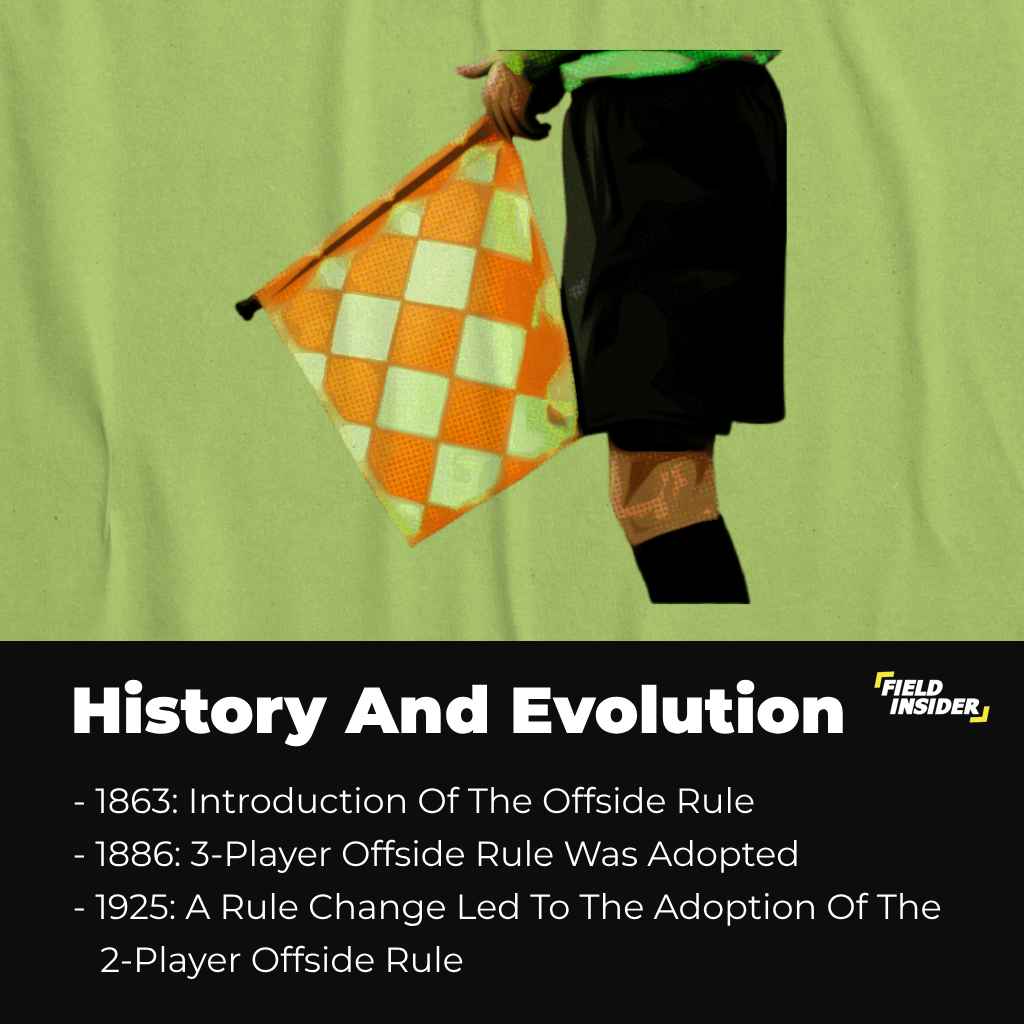
1886 (First Rule Change)
Later in 1886, the first amendment to the rule came with the introduction of the three-player offside rule. This would eventually open up strategies for more attack formations and make forward passes legal.
The three-player rule states that when the ball is played to a player (forward pass), he is not offside if there are three players of the opposing team in front of him (the goalkeeper and two other players).
1886 (IFAB Establishment)
Later, in 1886, the International Football Association Board (IFAB). This association was a conjunction of the English, Irish, Scottish, and Welsh football associations, which came to create unified laws.
1873 (Offside Call Determination)
A few years later, in 1873, the key change was made to the offside call. This means that offsides are not judged by where or when the ball is received, but rather when the pass is made.
This sets the framework for today’s rule, which states that the position of the receiving player the moment a pass is made is what determines the offside call and not his positioning when he receives it.
1907 (Attacking Half):
In 1907, it was established that offsides would only count in the attacking half of each team. This means that all passes made in their team’s half of the field are onside.
1921 (Throw-ins Exception)
The exception of throw-ins from the offside rule came in 1921. This meant that the ball could be thrown to any player in any area on the field. However, after the first contact, the offside rule resumes action.
1925 (Two Players Offside Rule)
1925 saw a change from the three-player offside rule that had been adopted since 1886, to the two-player rule.
Unlike the three-player rule, the two-player rule says, that an attacking player must have a goalkeeper and one more defending player ahead of him to be onside.
The Modern Offside Rule
The offside rule remained unchanged until 1990, when it was revised to state that an attacker is onside if level with the second-last defender, reducing the number of controversial decisions by linesmen.
In 2005, it was specified that offside decisions should consider a player’s head, body, or feet nearest to the opposition’s goal line, excluding arms and hands.
However, players can still be offside from free kicks.
Scenarios Of The Offsides Rule
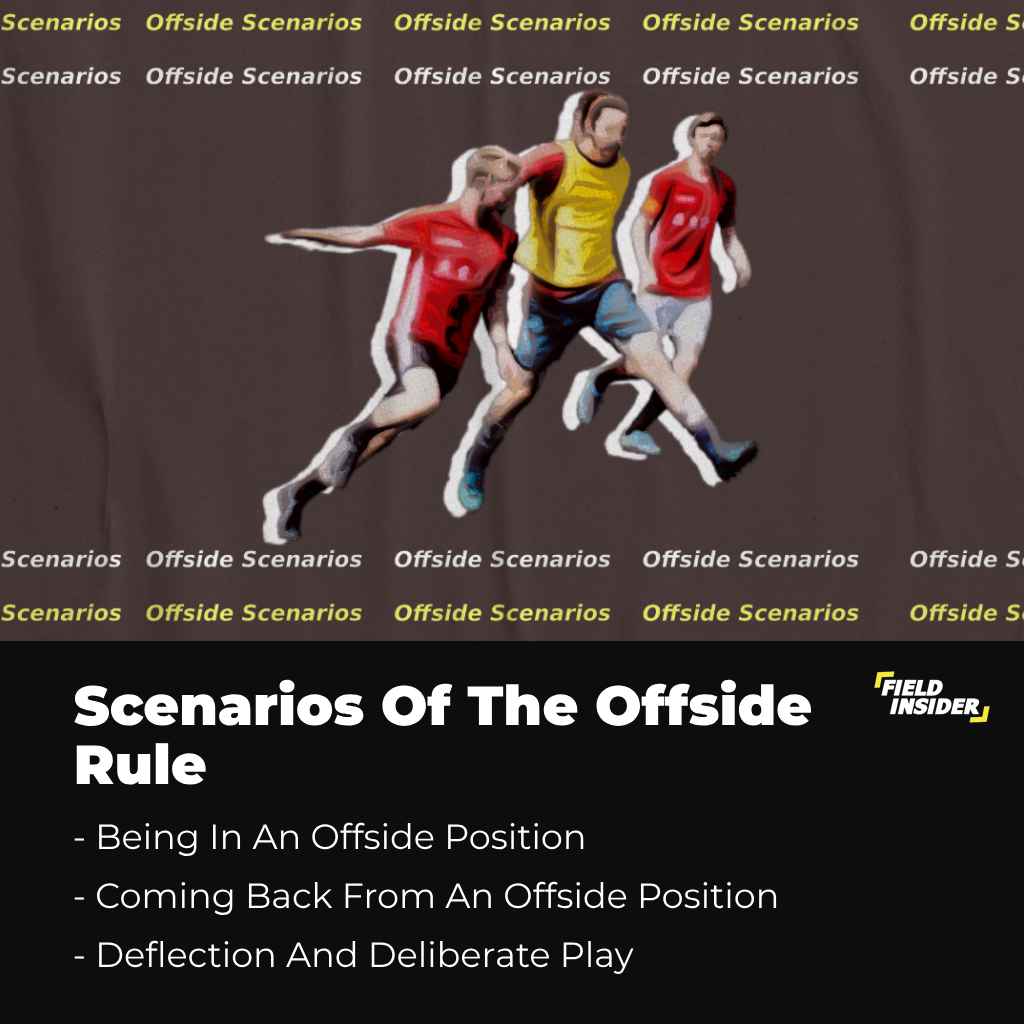
Being In An Offside Position
In football, it is important to note that being in an offside position is not a foul or offense. Players are not penalized for being in an offside position, however, they are when they interact with the ball when in an offside position.
Another major key determiner of whether an offside will be called is the position of the player when a pass is made to him.
As stated earlier, offside is a positioning error of a player when a pass is made. This means what determines what offside is not the position of the player after he receives a pass, but the position when the pass was made.
Scenario 1
In context, if a player is onside when a teammate makes a pass to him from behind, and he receives the ball when he is ahead of the second-last opponent (an offside position), an offside is not called.
This is because, at the point of making the pass, the player was onside.
Coming Back From An Offside Position
Another scenario we need to look at is an offside call when a player is coming back from an offside position.
If a player, formerly in an offside position when the ball is played by a teammate, makes it back to an onside position before making contact with the ball, an offside will be called if no other player made contact with the ball while he gained possession in his new onside position.
However, if another player from his team made contact with the ball after he became onside, then an offside would not be called.
Deflection And Deliberate Play
A subjective part of the offside rule is the part that deals with deflection and deliberate play. Before we go deep into it, let us first examine the difference between deflection and deliberate play.
Deliberate play (excluding deliberate handball) is when a player has control of the ball with the possibility of:
IFAB Rule Book
- passing the ball to a team-mate;
- gaining possession of the ball; or
- clearing the ball (e.g. by kicking or heading it)
As stated above in the IFAB rule book, any contact made by a player due to his having control over the ball is a deliberate play.
However, any other contact that was due to pressure, such as physical interference, is called a deflection.
Now, how does this apply to the offside rule?
Scenario 1 (Deliberate Play)
If a defending player plays the ball to an attacking player from the opposing team who is offside, this is counted as a deliberate play. Moreso, an offside call is not made.
In addition, if a player who is in control of the ball passes, kicks, or makes contact with the ball in any way and it later gets intercepted or repossessed by an opponent player who was offside, an offside is not called.
Scenario 2 (Deflection)
When the ball is sent to a player who is offside by a teammate and the ball comes in contact with a defending player from the opposing team who made an indeliberate play and the ball eventually gets to the offside player, offside is called.
The contact made by the defending player of the opposing team before getting to the offside player is called a deflection if it does not meet these requirements of what should be called a deliberate play.
IFAB Rule Book
- The ball travelled from distance and the player had a clear view of it
- The ball was not moving quickly
- The direction of the ball was not unexpected
- The player had time to coordinate their body movement
- A ball moving on the ground is easier to play than a ball in the air
If the offside player gains possession of the ball after the deflection on the opposing player, an offside is called.
This reason is subjective because the offside is based on what the linesman sees and his view on whether the contact with the player was deliberate.
France Vs Tunisia (Griezman Offside Goal)
In this qualification game where France faced Tunisia during the 2022 FIFA World Cup, a goal scored by Antoine Griezmann was disallowed due to offside.
A free kick was given to France, and the ball was played from the French kicker toward the direction of Griezmann, who was offside. After the kick was made, he became onside.
However, a defender from Tunisia moved to intercept the ball but was interfered with by a French player who was tackling him.
The Tunisian defender went on to head the ball slightly, and the ball fell right in front of Griezmann, who later fired a shot and scored.
The whistle was blown shortly after, and after checking the VAR, it was concluded that the Tunisian defender did not make a deliberate play as he was physically interfered with and was not in control of the ball direction.
This meant it was a deflection, and the goal was withdrawn.
Parts Of The Body Considered During Offside
The entire body part of a player is not considered when measuring if a player is ahead, behind, or on the same line as the second-last opponent.
According to the IFAB rulebook on offsides in soccer, the part of the body that must be ahead of the second-last opponent to count as offside is any part of the body that a goal can be scored.
Therefore, this includes the head, legs, shoulders, and other parts of the body except the hands (handball rule).
What Is The Penalty For An Offside Call?
Offsides are penalized by allowing the non-offending team a free kick which will be taken at the spot where the offside was made.
Moreso, irrespective of the number of times a player commits offside, they are not given any cards (either yellow or red).
Exemptions To Offside Rules
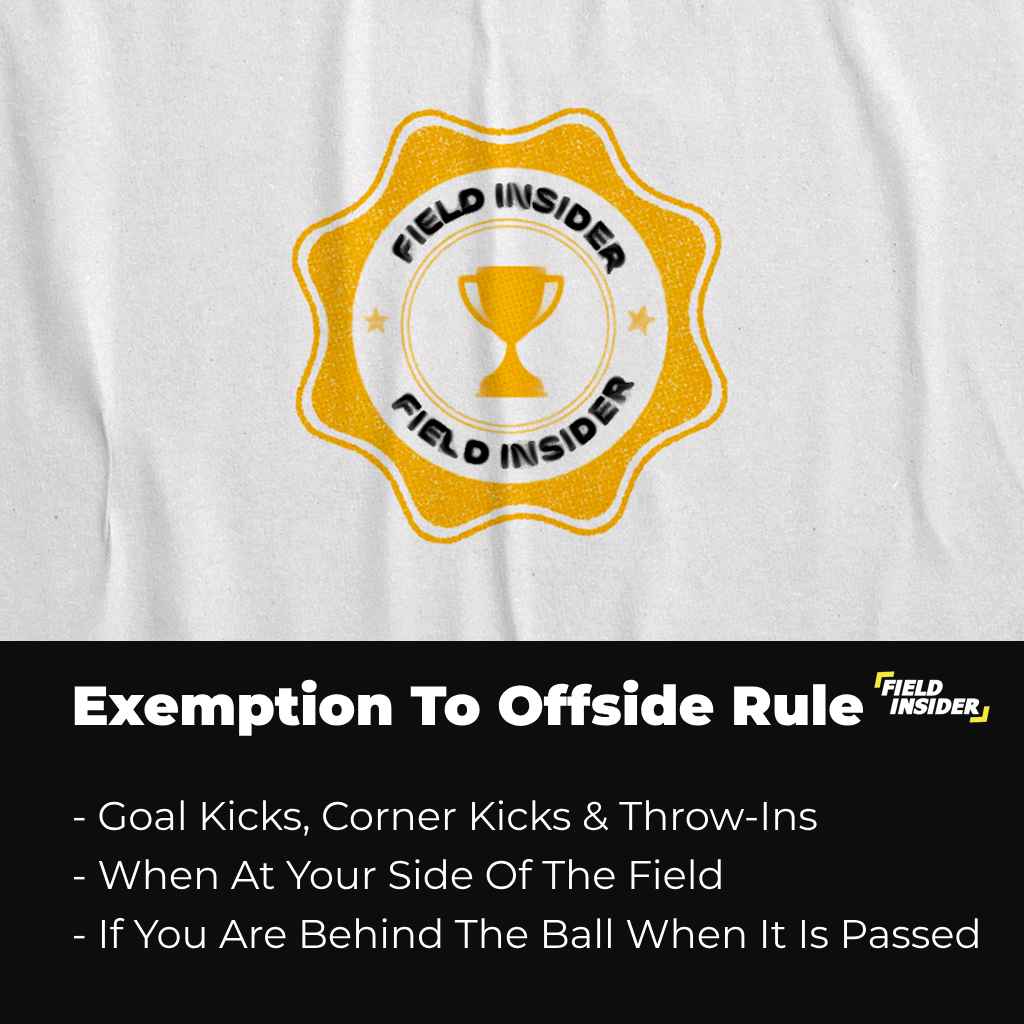
Goal Kicks, Throw-Ins And Corner Kicks
The first contact during a goal kick, throw-in, or corner kick does not count as an offside. This means that regardless of where that ball is played, an offside will not be given, no matter the position of his teammates.
However, after the first contact, the offside rule comes back into play, and the positioning of players matters again.
At Your Side Of The Field
Any pass made by players in their half of the field cannot lead to an offside call. This is because positioning errors can only occur on the opposing team’s side of the field.
If You Are Behind The Ball When It Is Passed
When a player is behind the ball when it is passed, it is not an offside, even if he is ahead of the second-last opponent and directly facing the goalkeeper.
A prominent example of this is a two-player breakaway where two players are ahead of all other members of the opposing team.
In this case, if the player in front of the breakaway makes a pass to the other player behind him (the second person in the breakaway), it won’t be counted as an offside even though they are way ahead of the second-last opponent.
The Role of the Linesman
Linesmen are part of the officials of the sport, and they play a major role in offside calls. Mostly, he is responsible for offside identification.
Whenever he sees an offside play, he notifies the referee by raising his flag, which will then lead to the stoppage of the match.
Positioned along the touchline, they have a clear view of the offside line and must make quick, accurate decisions. Their role is challenging, requiring keen observation and understanding of the game’s dynamics.
How to use the Offside Rule effectively?
Teams now frequently use the offside rule for tactical gains. This change came about as strikers used to linger near the goal to get the ball, prompting a rule revision.
Defenses today use the offside trap, a coordinated forward movement timed with the ball’s play to the attacker, to force offside calls and win free kicks.
Originating after the implementation of the offside rule, the offside trap requires careful practice and precise timing, as errors can result in the striker being onside and in a direct confrontation with the goalkeeper.
Besides trapping attackers offside, this strategy reduces their passing options, enhancing the defense’s chance to intercept.
However, slow defensive reactions or smart attackers who delay their runs can compromise the trap. Additionally, a secondary attacker might use the created space to regain control of the ball.
Applying the Offside Trap
Implementing the offside trap requires evaluating your team’s skill level and experience, as it’s a complex tactic not well-suited for youth or novice players.
Teams must be able to handle the psychological impact of errors in the offside trap, which can lead to goals against them.
This strategy is most effective against teams that frequently use through balls but less so against opponents with fast attackers who can outrun defensive setups. Slower attackers are more likely to fall victim to the trap.
For effective execution, a designated player, typically a center-back, should lead the offside trap due to their strategic positioning and game awareness.
Clear, precise communication from this player is essential for the trap’s success.
How to coach the Offside Trap?
For a training drill involving 16 players, set up three squares approximately 30 meters from the goal, one centrally and the others near each sideline.
In each square, position two attackers against one defender, creating a 2v1 scenario. The defending team includes a goalkeeper and a backline of four or five players, depending on your formation.
Add two extra attackers near the defensive line.
The coach initiates the drill by passing the ball into one of the squares. The attackers aim to move the ball out of the square and then pass it behind the defense for the two attackers to chase.
Place cones on the sideline to mark the defense’s starting point and the line they should advance to.
Award points to the attackers for each goal scored and to the defenders for every time they catch the attackers offside.
This exercise benefits both defenders and attackers. It teaches defenders to coordinate their movement to enforce offsides, while attackers learn to exploit gaps in a high defensive line.
The offside rule adds a tactical dimension to the sport, offering opportunities for teams to enhance their gameplay.
Filippo Inzaghi
Sir Alex Ferguson famously described Pippo Inzaghi as being “born offside”. Inzaghi, often the first name associated with offsides, holds the record for the most offsides in football history.
This tactic, however, proved fruitful, as he consistently scored goals by playing close to the last defender and capitalizing on errors.
His knack for circumventing offside traps contributed to his impressive tally of 197 career goals, winning the 2006 World Cup with Italy and securing two Champions League titles with AC Milan.
VAR Impacting Offside Decisions
The introduction of the Virtual Assistant Referee (VAR) in football is one of the newer technological introductions and dimensions to offside decisions in football.
They are a more precise tool for reviewing offside calls and lead to more accurate decisions. They are used on very delicate calls where there are debates on whether the call should be held or dismissed.
In addition, VAR also serves as a way to ensure fair play. It does this by ensuring that the right call is made especially in very critical situations.
Offsides In The Premier League
Clubs in the Premier League have learned to adapt to the offside rule and work their way around to benefit them.
From the data obtained from the Premier League of the recorded number of offsides for each season, there is a progressive decline in offsides for each season.
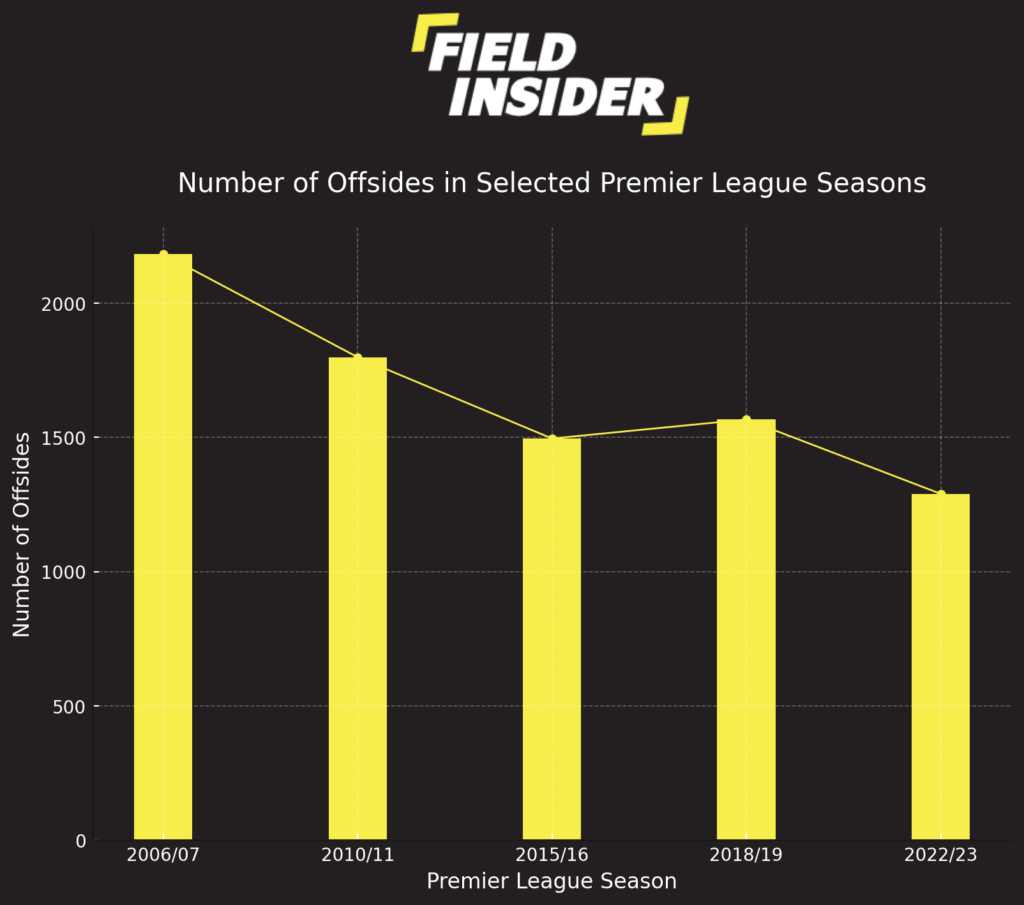
The chart above shows the number of offsides for a few Premier League seasons starting from 2006/07 season. From the table, there is a noticeable degression from 2183 offsides recorded for the ’07 season to 1290 offsides for the ’23 season.
| Premier League Season | Number of Offsides |
|---|---|
| 2022/23 | 1290 |
| 2018/19 | 1567 |
| 2015/16 | 1496 |
| 2010/11 | 1799 |
| 2006/07 | 2183 |
Who Has The Most Offsides In The Premier League?

| Players | Teams | Offsides |
|---|---|---|
| Emmanuel Adebayor | Arsenal, Manchester City, Spurs, Crystal Palace | 328 |
| Jermain Defoe | West Ham, Portsmouth, Spurs, Sunderland, Bournemouth | 314 |
| Darren Bent | Ipswich Town, Charlton Athl., Spurs, Sunderland, Fulham, Aston Villa | 276 |
| Dimitar Berbatov | Spurs, Manchester Utd., FC Fulham | 238 |
| Christian Benteke | Aston Villa, FC Liverpoool, Crystal Palace | 202 |
| Robin Van Persie | Arsenal, Manchester Utd. | 198 |
| Gabriel Agbonlahor | Aston Villa | 195 |
FIFA World Cup Match with Most Offsides
| Country | Year | Offsides |
|---|---|---|
| England vs Kuwait | 1982 | 20 |
| Czechoslovakia vs Kuwait | 1982 | 18 |
| England vs France | 1966 | 16 |
| Italy vs Argentina | 1990 | 16 |
| Spain vs Algeria | 1986 | 15 |
Conclusion
In conclusion, the offside rule is integral to football’s appeal, making the game what it is today. Despite its controversial history, it’s now a cornerstone of modern football, especially with the precision of VAR-reducing errors.
Teams strategically use the offside rule for both defense and attack, with tactics like offside traps and countermeasures enriching the game’s complexity and excitement.
This aspect of football is a key reason why fans are so passionate about the sport.


